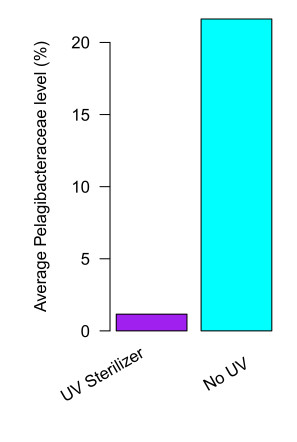UV sterilizers almost completely eliminate the Pelagibacteraceae
This group is 18 times less abundant on average in tanks with UV than in tanks without. In fact, nearly all tanks with UV sterilizers (98%) have very low Pelagibacteraceae levels (<5%). This effect is so strong we can typically recognize tanks with UV just by looking at their community composition.

Pelagibacteraceae are the most abundant group on natural reefs
A recent study found that Pelagibacteraceae were among the top 3 most abundant families in seawater from coral-dominated communities on the Great Barrier Reef (source). Interestingly, this family was found at lower levels in high-nutrient, inshore habitats dominated by macroalgae. Even in those habitats, however, Pelagibacteraceae remain among of the top 3 most abundant families.
This comparison emphasizes that growing corals in a microbial community without Pelagibacteraceae represents a major deviation from natural conditions.
Recommendations for UV sterilizers in reef tanks
Many reef keepers have found UV sterilizers to be useful tools for controlling outbreaks of nuisance algae, turning the UV on as needed. This seems like a safer and more reasonable use of UV, since the effects of the UV can be monitored visually and it can be turned off again once the problem is resolved.
Some aquarists run UV preventatively in an effort to prevent disease outbreaks. We advise against this practice for reef tanks, since it alters the microbial community so dramatically.
Overall we view UV as similar to a strong dose of antibiotics – not something to be administered constantly, but used as needed for especially difficult infections (or nuisance algae).
